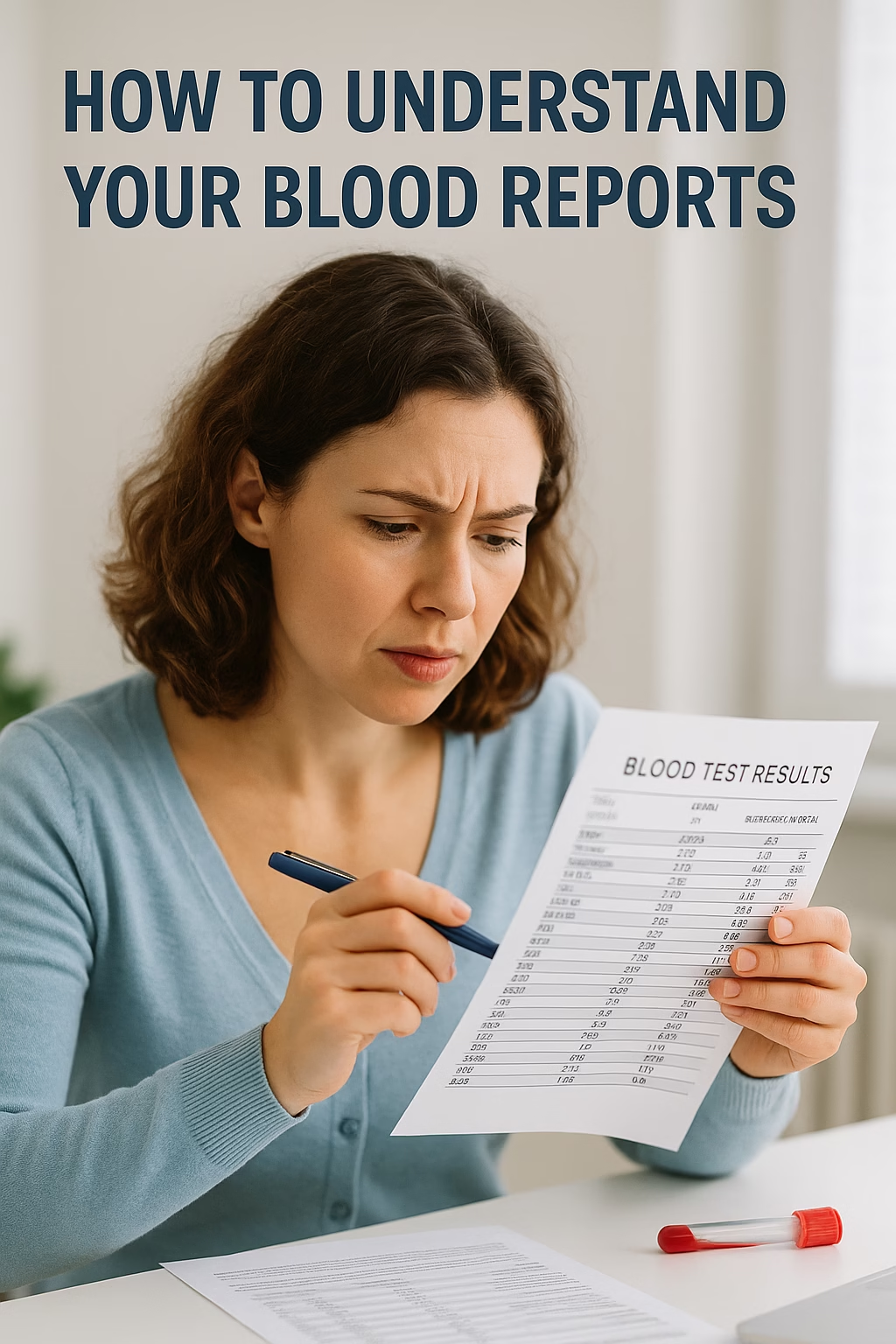
Getting your blood test report back can feel intimidating—filled with medical terms, numbers, and ranges that seem hard to make sense of. But understanding the basics of your blood reports can empower you to take better care of your health. Blood tests are among the most common tools doctors use to check overall well-being, detect conditions early, and track ongoing treatments. In this blog, we’ll break down your blood reports in simple, easy-to-follow language so you can feel more confident reading them.
Why Blood Reports Matter?
Blood tests give a snapshot of your body’s overall health. They help in:
- Detecting diseases early (like diabetes, thyroid disorders, or anemia).
- Monitoring existing health conditions.
- Tracking how well treatments or medications are working.
- Preventing future complications through lifestyle adjustments.
Components of a Blood Test
A blood test usually consists of three major tests:
- Complete Blood Count (CBC)
- Comprehensive Metabolic Panel (CMP)
- Lipid Panel
Complete Blood Count (CBC)
The CBC measures the volume of blood cells, allowing a doctor to assess an individual’s overall health as well as look for underlying illnesses like leukemia and anemia.
The complete blood count (CBC) concentrates on the three types of blood cells:
- White blood cells (WBCs)
- Red blood cells (RBCs)
- Platelets.
The CBC includes the following subtests:
White blood cell (WBC) count
White blood cells, often known as leukocytes, are essential components of the immune system. A high white blood cell count can indicate the presence of infection, whereas a low count can lead to several illnesses, including HIV, leukemia, hepatitis, and arthritis.
Differential white blood cell count
The lab assesses the five major components of white blood cells and their proportion to one another. If the components are out of balance, it could suggest an infection,as well as a variety of medical conditions. Healthy proportions for each are as follows:
Differential White Blood Cell Count (with table)
| Type of Cell | Normal Range |
| Neutrophils | 40-60% |
| Lymphocytes | 20-40% |
| Monocytes | 2-8% |
| Eosinophils | 1-4% |
| Basophils | 0.5-1% |
Source: MedlinePlus (U.S. National Library of Medicine, NIH)https://medlineplus.gov/lab-tests/white-blood-cell-differential/
Note: Stress or even a mild cold can change WBC count.
Red blood cell (RBC) count
Red blood cells (RBCs) transport oxygen to tissues throughout the body, making them essential for its proper functioning. A red blood cell count evaluates the volume of RBCs in an individual; if the findings show a count above or below normal values, a doctor can diagnose a variety of medical issues. However, this type of testing is unable to identify the underlying causes of any anomalies; thus other tests will be required.
Normal RBC ranges are:
| Male | 4.7 to 6.1 million cells per microliter (cells/mcL) |
| Female | 4.2 to 5.4 million cells per microliter (cells/mcL) |
Source:University of California, San Francisco (UCSF) Health https://www.ucsfhealth.org/medical-tests/red-blood-cell-count
Note: Low RBC may make you feel weak, but it can often be improved with diet or treatment.
Hemoglobin (Hgb) test
Hemoglobin is a complex protein present in red blood cells that helps circulate oxygen throughout the body and transport carbon dioxide from tissues to the lungs.
Normal hemoglobin levels in the blood typically depend on sex, age and general health.
| Age/ Gender | Normal Range |
| Newborn | 14-24 g/dL |
| Adult men | 14-18 g/dL |
| Adult women | 12-16 g/dL |
Low → anemia, bleeding, malnutrition.
High → dehydration, lung disease, smoking.
Source:MedlinePlus (U.S. National Library of Medicine, NIH)https://medlineplus.gov/lab-tests/hemoglobin-test/
Hematocrit (HCT) test
Tests the proportion of RBCs in the blood.
Low → anemia.
High → dehydration or lung disease.
Mean corpuscular hemoglobin (MCH) test
The lab measures the average amount of hemoglobin per RBC.High levels may indicate anemia, whereas low levels may indicate malnutrition.
Mean corpuscular volume (MCV) test
This test measures the average volume of RBCs, or the amount of space that each red blood cell takes up. Results outside of the normal range may indicate anemia or chronic fatigue syndrome, among other medical issues.
Platelets
Platelets are cell fragments that help the blood clot. This test determines the number of platelets present in the blood. If testing reveals a high level, it may indicate anemia, malignancy, or infection, whereas a low count might hinder wound healing and cause serious bleeding.
Quick reference:
Normal: 150,000 – 450,000 /µL
Thrombocytopenia (low platelets): <150,000 /µL
Thrombocytosis (high platelets): >450,000 /µL
Mean platelet volume (MPV)
It measures the average size of platelets in the blood. A low platelet volume can induce bleeding abnormalities, whereas a high platelet volume increases the risk of a heart attack or stroke.
Note: If platelets are slightly high/low, don’t panic—it may be temporary.
Comprehensive Metabolic Panel(CMP)
The comprehensive metabolic panel test, commonly referred to as a chemical panel, assesses the body’s glucose levels, fluid and electrolyte balance, and liver and kidney function. It includes a number of subtests:
Alanine aminotransferase (ALT) test
Alanine aminotransferase (ALT) is an enzyme produced mostly by liver cells. High amounts could indicate liver damage.
Albumin test
Albumin is a protein made by the liver. This test measures the amount of albumin protein in blood, which reflects liver and kidney function. Abnormal levels may be caused by liver or renal issues.
Total protein test
It measures the ratio of two types of proteins, albumin and globulin.Low protein levels can suggest a variety of illnesses, including liver and kidney disease and malnutrition, whereas high levels can indicate inflammation, infection, or a bone marrow issue.
Aspartate aminotransferase test
Aspartate aminotransferase is an enzyme that is found in red blood cells, muscle tissue, the heart, pancreas, liver, and kidneys. This test determines the levels of this enzyme in the body, with findings above the normal range indicating a number of diseases, such as cancer, liver, heart, or kidney damage.
Bilirubin test
Bilirubin is a liver and bile metabolism marker that can help diagnose disorders such as neonatal jaundice, anemia, and liver disease.
Blood glucose test
For screening of diabetes.
Calcium blood test
Determines whether you have enough levels of calcium, a mineral that aids in many of your body’s processes. If testing reveals low levels, this could indicate underactive parathyroid glands, insufficient calcium in your diet, vitamin D deficiency, or other less frequent diseases.
Creatine kinase (CK) test
Creatine kinase is an enzyme released when muscles are damaged. High creatine kinase readings may indicate injured or damaged muscles.
Blood urea nitrogen (BUN) test
Determines the amount of urea, a waste product that passes through the kidneys. BUN tests measure the urea nitrogen in blood to assess kidney function.
Phosphorus test
The lab measures the level of phosphorus in the blood. Elevated levels may indicate renal or parathyroid gland disorders, as well as malnutrition or alcohol addiction.
Sodium test
Sodium is a mineral that helps nerve impulses and muscle contractions, as well as regulates water levels. Irregularities may indicate dehydration, adrenal gland dysfunction, corticosteroids, or kidney or liver disease.
Potassium test
Potassium improves nerve-muscle communication, regulates the heart, and keeps muscles working properly. Diuretics (a chemical or drug used to stimulate urination) can lower potassium levels.
| Test | Normal Range |
| Calcium | 8.5 – 10.2 mg/dL |
| Glucose | 70-99 mg/dL |
| Sodium (Na⁺) | 135 – 145 mEq/L |
| Potassium (K⁺) | 3.5 – 5.0 mEq/L |
| BUN (Blood Urea Nitrogen) | 7 – 20 mg/dL |
| Creatinine | 0.6 – 1.3 mg/dL |
| Total Protein | 6.0 – 8.3 g/dL |
| Albumin | 3.5 – 5.0 g/dL |
| Globulin | 2.0 – 3.5 g/dL |
| Total Bilirubin | 0.1 – 1.2 mg/dL |
| ALP (Alkaline Phosphatase) | 44 – 147 U/L |
| AST (SGOT) | 10 – 40 U/L |
| ALT (SGPT) | 7 – 56 U/L |
Source: MedlinePlus (U.S. National Library of Medicine, NIH).Comprehensive Metabolic Panel (CMP) Test.
https://medlineplus.gov/lab-tests/comprehensive-metabolic-panel-cmp/
Note: Dehydration can affect sodium and potassium levels.
Lipid Panel
The lipid panel comprises many tests that assess the various forms of triglycerides (fats) and cholesterol in the bloodstream.
Total cholesterol test
This test analyzes the total amount of LDL (bad) and HDL (good) cholesterol in the blood.
Triglyceride test
Triglyceride tests look for a type of fat in the blood. Irregularities may increase the chance of developing heart disease and other medical conditions.
HDL Cholesterol test
HDL cholesterol, commonly known as high-density lipoprotein (or “good cholesterol”), can help prevent heart disease. Low amounts can raise the risk of cardiac issues.
LDL Cholesterol test
LDL cholesterol, commonly known as low-density lipoprotein (or bad cholesterol), is associated with heart disease and clogged arteries.
Total Cholesterol to HDL ratio test
Calculating this ratio can assist determine a person’s risk of acquiring heart disease.
Formula:
Cholesterol Ratio=Total Cholesterol/HDL Cholesterol
General Guideline:
- Ideal: < 3.5
- Good: 3.5 – 4.5
- Borderline: 4.5 – 5.0
- High risk: > 5.0
Lipid Panel Range Table (for adults):
| Test | Desirable/ Normal | Borderline | Higher/ Risky |
| Total Cholesterol | < 200 mg/dL | 200 – 239 mg/dL | ≥ 240 mg/dL |
| LDL(Bad Cholesterol) | <100 mg/dL (optimal)
100–129 mg/dL (near optimal) |
130 – 159 mg/dL | 160–189mg/dL (high)
≥190mg/dL(very high) |
| HDL(Good Cholesterol) | ≥60mg/dL(protective) | 40 – 59 mg/dL | <40 mg/dL (low, heart risk) |
| Triglycerides | < 150 mg/dL | 150 – 199 mg/dL | 200–499 mg/dL (high)
≥ 500 mg/dL (very high) |
Source: National Institutes of Health (NIH). Cholesterol Guidelines and Patient Education Resources. www.nih.gov
Important Note
The ranges shared here are general guidelines. Normal values may vary from lab to lab. Always confirm your results and their meaning with your doctor or healthcare provider.
How to Read Your Report Safely
- Don’t panic if one value is slightly off – stress, dehydration, or even food can affect results.
- Always compare with the normal range shown in your report.
- Use your results as a conversation starter with your doctor, not as a final answer.
- Focus on long-term habits → balanced diet, regular exercise, good sleep.
Quick Takeaway
If your report shows abnormal values, always consult a doctor instead of Googling symptoms. Blood tests tell a story — but only your doctor can interpret it correctly.
Frequently Asked Questions (FAQs)
- Why are blood tests important?
Blood tests help doctors check overall health, diagnose conditions, monitor treatment, and detect problems early (like anemia, diabetes, infection, liver or kidney issues).
- Do I need to fast before a blood test?
Some tests (like glucose, lipid panel) require fasting for 8–12 hours, but not all. Always follow your doctor’s instructions.
- How often should I get blood tests done?
Healthy adults: once a year (as part of a routine checkup).
People with chronic conditions (like diabetes, heart disease): more frequently, as advised by the doctor
- What is a CMP (Comprehensive Metabolic Panel)?
A CMP checks blood sugar, electrolytes, liver, and kidney function useful for overall body health.
- Can I check my blood reports myself?
You can understand basic ranges (normal, high, low), but always consult a doctor for proper interpretation.
Discover more from The Vigyan Chronicles
Subscribe to get the latest posts sent to your email.



